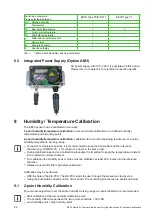
10
EE33 Humidity / Temperature Sensor for High Humidity and Chemical Applications
4.1.3 Dual Heating System with Overheating (OH)
In environments with continuous high humidity even the smallest deviations between the temperature
of the sensor head and the ambient temperature can cause condensation. Dew on the RH/T sensing
element influences the accuracy of the measurement and increases the risk of deposits on the active
sensor surface that lead to parallel resistances and parasitic capacitances.
The dual heating system of the EE33 prevents both: condensation on the RH sensing element and
on the probe body by a regulated heating strategy. This leads to very short response time and fast
recovery after condensation. Furthermore, it enables precise RH measurement even under continuously
high humidity and condensing conditions. RH and T of the heated sensing element can be determined
precisely thanks to its monolithic structure and the dew point of the environment is calculated. If the
relative humidity has to be determined near condensation, the ambient temperature can be measured
with an additional T sensor to calculate the relative humidity.
The following EE33 types incorporate the dual heating system:
T7:
for Td measurement only
T17: with additional T Sensor included for RH measurement
T28: with additional T Sensor included for RH measurement in meteorological applications
4.1.4 Overview Heating Modes and Types
Heating Mode
Condensation Prevention
(CP)
Automatic ReCovery
(ARC)
OverHeating (OH) with
Dual Heating System
Use
Against temporary condensation
Against chemical pollution
In environments with
continuous high humidity and
condensation
Function Trigger
RH setpoint
*
)
Cyclic, externally, manually
Always ON
EE33 Type
EE33 Type T4/T5/T8/T10
Not available
EE33 Type T7/T17
Not usable due to OH
EE33 Type T28
Not usable due to OH
*
)
F
actory setting: disabled, RH setpoint preset to 99 %.
4.2 Dimensions
135
(5.3)
163
(6.4)
66.5
(2.6)
90
(3.5)
Fig. 1 EE33 metal enclosure











































